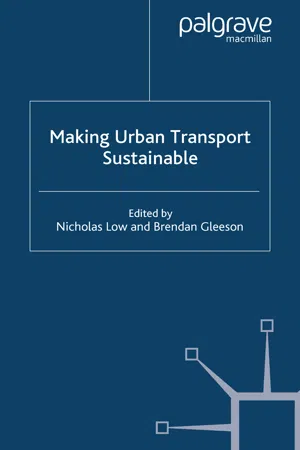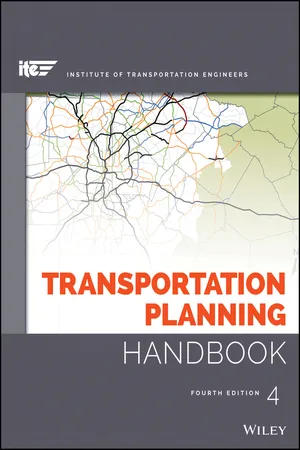Geography
Transport and Environment
Transport and environment refers to the relationship between transportation systems and their impact on the natural world. This includes the environmental effects of various modes of transportation, such as air and water pollution, habitat destruction, and greenhouse gas emissions. It also encompasses efforts to mitigate these impacts through sustainable transportation practices and policies.
Written by Perlego with AI-assistance
Related key terms
1 of 5
6 Key excerpts on "Transport and Environment"
- eBook - PDF
- N. Low, B. Gleeson, N. Low, B. Gleeson(Authors)
- 2002(Publication Date)
- Palgrave Macmillan(Publisher)
Transportation systems are seen naturalistically as a part of human ecologies. McKenzie quotes Hadley: ‘It is this quickening and cheapening of transportation that has given such stimulus in the pre- sent day to the growth of large cities. It enables them to draw cheap food from a far larger territory and it causes business to locate where the widest business connection is to be had, rather than where the goods or raw mate- rials are most easily produced’ (McKenzie, 1967: 69 n2). 1 Transport negates the effect of space and enlarges the competing popula- tion of firms and households by bringing more people and products within reach of one another. This view of the world infuses the publications of the European Commission (see Chapter 13 of this volume). The American econ- omist Paul Krugman (1999: 85) writes with delight about ‘globalization’ which puts fresh vegetables from Zimbabwe on the tables of Londoners. Whitelegg writes not with delight but dismay about the 150 gram pot of 6 Making Urban Transport Sustainable strawberry yoghourt which is responsible for moving one lorry 9.2 metres in the process of production (Whitelegg, 1997: 39 citing research by Böge, 1995). Both are tales of spatial expansion and flexibilisation, principles of the globalization of the market economy: the ever increasing choice of location of production of anything and everything. Economic rationality contains two kinds of problem for transport sustainability, one external, to do with the subject matter (transport), and one internal to the theory of economics itself. The external problems have to do with the nature of transport. First, the disaggregation entailed in the market mechanism tends to work against the technical co-ordination (intermodal, intertemporal and geographical) required by an effectively functioning transport system. Rothengatter (1994: 125) points to the prob- lem of natural monopolies in transport networks, but the matter goes deeper than that. - eBook - ePub
- Jonathan Cowie, Stephen Ison, Jonathan Cowie, Stephen Ison(Authors)
- 2017(Publication Date)
- Taylor & Francis(Publisher)
Transport systems are critical to all economies and provide substantial benefits to individuals and industry in terms of employment, prices and overall economic growth (European Conference of Ministers of Transport, 2001). In 2013 transport employed around 11 million persons, 5.1 percent of the total workforce in the EU28 and accounted for about 4.9 percent of the gross value added in the EU28 in 2012. These benefits, however, are not without cost. There is well-documented evidence that transport creates substantial externalities through the impacts of congestion, air pollution, noise, accidents and many other factors (Banister, 1998). Indeed, some examples of these are found in other chapters within this book, such as aviation (Chapter 6), private transport (Chapter 13) and road freight (Chapter 21). In addition to these external costs there are other social and distributional costs where the impact on society, such as social exclusion, severance and other equity considerations, is hard to quantify and rarely measured (see Adams, 1999).The relationship between transport and the environment has always been a complex one. In some cases the environment facilitated transport operations through the provision of excellent waterways and natural harbours. There are examples of some city locations and their development, for example the port of Valletta, Malta (Chapman and Cassar, 2004) and Melbourne, Australia (Wilkinson et al., 2013), which provide ample evidence of the importance of the environment as a resource:The role ecosystems play in historic patterns of urban development is clearly recognized. The 1954 Melbourne plan, for example, states ‘thus because of the provisions of nature, we find Melbourne the seat of government, the centre of import and export’ (MMBW, 1954, p. 27). This is a reference to the fact that ‘Port Phillip Bay, at the head of which stands Melbourne, [is] the only body of water offering opportunities for large scale harbor development in over 1000 miles of coastline’ (MMBW, 1954, p. 27), that extensive timber and pastoral land was present and that a natural freshwater supply existed by virtue of an existing ledge of rock across the Yarra River ‘sufficient to prevent tidal water from traveling much further upstream’ (Presland, 2009, p. 20). Provisioning services, including ‘food’ and ‘freshwater’, are thus recognized as critical. - eBook - ePub
- Michael D. Meyer(Author)
- 2016(Publication Date)
- Wiley(Publisher)
This chapter describes the role of environmental impacts and consequences in the transportation planning process. The intent is to discuss ways to incorporate environmental considerations in the planning process so that decisions made early in the process will remain valid for later environmental regulatory reviews and documentation. This chapter also discusses considerations for determining the appropriate level of detail for environmental analysis and documentation during planning. The second section provides an overview of the role environmental considerations play in transportation policy and decision making, followed by general principles that should guide them. The next several sections present more detailed information by impact category, followed by construction-related environmental effects. The final two sections describe how to assess and document mitigation strategies in the systems planning process.II. ENVIRONMENTAL CONSIDERATIONS IN TRANSPORTATION PLANNING AND DECISION MAKING
As will be seen in subsequent sections, environmental considerations are found throughout the transportation planning and decision-making processes. The following paragraphs discuss four major concept/linkages that are found in most current practice: sustainability, environmental considerations at the systems level, environmental considerations in project development, and linking the latter two, as one progresses from systems planning to project development.A. Sustainability
Sustainability, or sustainable development, has received increasing focus as a desirable societal goal since the mid-1980s, when a United Nations commission defined sustainable development as “meeting the needs of the present without compromising the ability of future generations to meet their own needs.” [United Nations World Commission on Environment and Development (Brundtland Commission), 1987] This definition was further refined to include the Triple Bottom Line of economic development, social equity, and environmental quality, defined by the American Association of State Highway and Transportation Officials (AASHTO) as follows and shown in Figure 4.1 .Triple Bottom Line of SustainabilityFigure 4.1- Economy—Support economic vitality while developing infrastructure in a cost-efficient manner. Costs of infrastructure must be within a society's ability and willingness to pay. User costs, including private costs, need to be within the ability of people and households to pay for success.
- eBook - PDF
- Noel Castree, David Demeritt, Diana Liverman, Bruce Rhoads, Noel Castree, David Demeritt, Diana Liverman, Bruce Rhoads(Authors)
- 2009(Publication Date)
- Wiley-Blackwell(Publisher)
At the same time, it is important to note that although the field of environmental geography is increas-ingly international in its scope and membership, our contributors hail largely, but by no means exclusively from the UK and North America. In part, this is a function of our own personal and professional histories of living, studying and working on both sides of the Atlantic. (The anglophone focus of this Companion partly reflects the barriers which need to be overcome to create a truly international environmental geography, although some contributions certainly acknowledge the considerable influence of non-English-speaking theorists and analysts of environment [in envi-ronmental discourses or development theory for example] and cite important inter-national collaborative work [in land science for example].) Rather than trying to summarise the contents of each and every chapter, we want instead to provide an overview of the wider landscape of research, practice and knowledge to which they contribute. As a result, the next three sections of this introduction are devoted to making sense of the complicated intellectual landscape that is environmental geography. There are a number of important and interesting issues to consider here, starting with definitional ones. Defining Environmental Geography The term ‘environmental geography’ is not one that most geographers to whom it could reasonably apply usually use to identify themselves or their work. Instead, geographers more typically imagine their discipline as one of two halves – human and physical. Within those two broad churches, there are numerous subfields, like economic geography or geomorphology, with which specialists identify. - eBook - PDF
- Patrick Wiegand(Author)
- 1998(Publication Date)
- Continuum(Publisher)
CHAPTER 6 Environmental Geography and Environmental Education Pupils should demonstrate their increasing knowledge and understanding of: (i) the use and misuse of natural resources; (ii) the quality and vulnerability of different environments; (iii) the possibilities for protecting and managing environments. (Attainment Target 5, Department of Education and Science, Geography in the National Curriculum (England) HMSO, March 1991, p. 25) It may be helpful at the outset to distinguish between environmental geography (i.e. Attainment Target 5 of the National Curriculum for geography) and environmental education (defined by the National Curriculum Council as a cross-curricular theme). Environmental education views the planet as a life-support system and studies the threats that are posed to it. The attention of the world was drawn to environmental issues after publication of the declaration by the United Nations Intergovernmental Conference on Environmental Education in Tbilisi, USSR, in 1977 and the publication by the International Union for the Conservation of Nature (IUCN) of the World Conservation Strategy (1980). Both these documents emphasized the interdependence of human and physical systems, e.g.: By adopting a holistic approach rooted in a broad interdisciplinary base, it [i.e. environmental education] recreates an overall perspective which acknowledges the fact that natural environment and man-made environment are profoundly interdependent. It helps reveal the enduring continuity which links the acts of today to the consequences of tomorrow. It demonstrates the interdependencies among national communities and the need for solidarity among all mankind. (Tbilisi declaration, 1977) Public awareness of environmental education received a further boost from the 'Earth Summit' held in Rio de Janeiro in 1992. Current approaches in environmental education in school reflect the recognition that local environ-ments are part of the global ecosystem. - eBook - PDF
- R. Knowles, J. Wareing(Authors)
- 2014(Publication Date)
- Made Simple(Publisher)
Technology, in the form of efficient transport systems, has enabled man to bring resources together in convenient locations and to produce distribution patterns which are not directly dependent on the physical environment. The built environment is largely a product of the social environment within which it has been developed. However, the interaction necessary to overcome the problem of widely distri-buted resources takes place within the spatial environment and the character-istics of this environment, especially the effects of distance and location, have played an important part in producing the patterns of human activity of interest to the geographer. As a result, it is necessary to understand how space is perceived and measured. The Importance of Distance In any study of the spatial environment, distance must be a central focus because it forms the basic dimension of space and has a considerable influence on the operation of the spatial system. There are four ways in which spatial processes are affected by distance. 32 Economic and Social Geography Made Simple First, any movement of goods, people, services or information between places will involve a cost, which might be a bus fare or freight rate or simply the effort of walking. Secondly, this movement will take time, which is of considerable value, and which will limit the distance that items such as perish-ables can be sent. As a result, the interaction of cost- and time-distance raises obstacles to movement, and has two further consequences for spatial pro-cesses. Thirdly, distance limits the range of opportunities available to people, and shoppers in small provincial towns will normally have to make do with a limited range of goods locally while knowing of better opportunities in Lon-don, because of the time and cost involved in travelling to London to shop.
Index pages curate the most relevant extracts from our library of academic textbooks. They’ve been created using an in-house natural language model (NLM), each adding context and meaning to key research topics.





